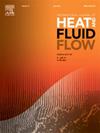采用 NACA 4822 不对称翼片的 PCHE 中的 SCO2 在海洋滚动条件下的热液压性能
IF 2.6
3区 工程技术
Q2 ENGINEERING, MECHANICAL
International Journal of Heat and Fluid Flow
Pub Date : 2024-10-07
DOI:10.1016/j.ijheatfluidflow.2024.109601
引用次数: 0
摘要
为了提高印制电路热交换器(PCHE)在海洋滚动条件下的传热效率,创新性地提出了一种 NACA 4822 非对称翼翅的分形结构。这种新结构具有两层通道:上层用于热二氧化碳,下层用于冷二氧化碳。值得注意的是,非对称翼翅结构的传热系数在 1.0 到 3.5 之间有显著提高,摩擦因数比在 0.6 到 1.3 之间,具有降低压降和增强传热的双重优势。在对 PCHE 中的分形结构非对称翼翅进行严格分析的基础上,通过不同的滚动周期和角度对其性能进行了评估。我们的研究结果表明,就传热性能而言,2.0 秒的滚动周期优于 4.0 秒的滚动周期。具体而言,在滚动角度为 30° 时,热性能飙升了约 2.0 至 4.7 倍,这表明滚动角度越大,传热效果越好。有趣的是,轧制角对传热性能的影响超过了轧制周期。本文章由计算机程序翻译,如有差异,请以英文原文为准。
Thermo-hydraulic performance of SCO2 in PCHE with NACA 4822 asymmetric airfoil fins under ocean rolling conditions
To enhance the heat transfer efficiency of a printed circuit heat exchanger (PCHE) under ocean rolling conditions, a fractal structure of the NACA 4822 asymmetric airfoil fins was proposed innovatively. This new configuration features two layers of channels: the upper is dedicated to hot CO2 while the lower is aimed for cold CO2. Notably, the asymmetric airfoil fin structure exhibits a remarkable improvement factor of heat transfer ranging from 1.0 to 3.5, accompanied by a friction factor ratio varying between 0.6 and 1.3, which signifies a dual benefit of reduced pressure drop and augmented heat transfer. Under rigorous analysis of the fractal-structured asymmetric airfoil fins in the PCHE, their performance is evaluated through varying rolling periods and angles. Our findings reveal that a rolling period of 2.0 s outperforms a rolling period of 4.0 s in terms of heat transfer performance. Specifically, at a rolling angle of 30°, the thermal performance soars by approximately 2.0 to 4.7 times, which indicates a positive correlation between a larger rolling angle and enhanced heat transfer. Intriguingly, the influence of the rolling angle on heat transfer performance eclipses that of the rolling period.
求助全文
通过发布文献求助,成功后即可免费获取论文全文。
去求助
来源期刊

International Journal of Heat and Fluid Flow
工程技术-工程:机械
CiteScore
5.00
自引率
7.70%
发文量
131
审稿时长
33 days
期刊介绍:
The International Journal of Heat and Fluid Flow welcomes high-quality original contributions on experimental, computational, and physical aspects of convective heat transfer and fluid dynamics relevant to engineering or the environment, including multiphase and microscale flows.
Papers reporting the application of these disciplines to design and development, with emphasis on new technological fields, are also welcomed. Some of these new fields include microscale electronic and mechanical systems; medical and biological systems; and thermal and flow control in both the internal and external environment.
 求助内容:
求助内容: 应助结果提醒方式:
应助结果提醒方式:


